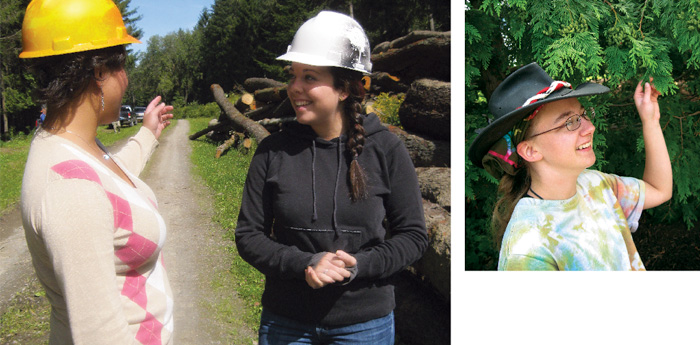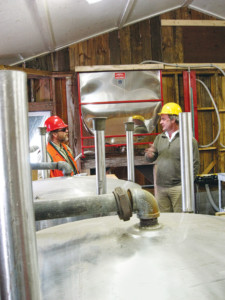S tudents in the managerial economics classes of Dr. John E. Wagner last semester nurtured a mutually beneficial, symbiotic approach to sustainable forest management with Robert Davis, director of forest properties, which is unique to ESF and an innovation recognized by environmental educators at conferences across the nation.
“Everyone’s looking at what we’re doing here and saying, ‘Wow!’” Davis said.
ESF has natural resources in Central New York and the Adirondacks that are the envy of other institutions, Davis said, and Wagner’s classes are making use of them in ways never before explored.
“Our 25,000 acres and eight forest properties are our classrooms,” Davis said.
The opportunity to work with Davis and his staff presented an option in forest economics education that is unheard of elsewhere in the Northeast, said Wagner, and that has helped shape his teaching. Wagner wrote the book “Forestry Economics: A Managerial Approach,” published in 2012 by Routledge Press, London, and said he initially addressed his classes from the viewpoint of an economist educating economists. That changed as he recognized the plans, interests and career prospects of the students he works with at ESF are more likely to be down-to-earth than to involve academic research.
“I fundamentally changed the method I used to approach the class,” he said. “My assumption now is that they’re going to be in business.”
Whether they work with a for-profit company or a nonprofit organization, Wagner said, they need to be able to develop a working and sustainable business plan for their projects. They do precisely that in his class. The semester’s assignment called for students to draw up a 10-year business plan with cash flow spreadsheets estimating costs and revenue.
As Wagner was developing a revised syllabus for tangible cost-benefit analysis he met Davis and realized “he was trying to do something similar, but for an entirely different reason.”
Davis was evaluating the forest properties operations at ESF’s wooded reserves to figure out how to run them economically and sustain them for continued use by ESF students and faculty while facing the ever-present risk of limited support from Albany. In the process he was gathering information on the College’s forest assets, timber production and operating costs.
Finding a ready source of raw numbers was a boon for Wagner’s plan for his classes to make a practical application of the tenets drawn up in his book.
“I can use actual data rather than hypothetical data,” Wagner said.
The single-semester class in Natural Resources Managerial Economics (FOR 333/533) is a required course for undergraduates majoring in forest resources management, natural resources management and sustainable energy management and for graduate students seeking a master’s degree in forestry.
It’s also a practical learning experience for all involved. Students choose which existing forest properties operation they want to model and brainstorm to gather ideas for potential new products. They make two trips into the field to study existing operations and get an idea of how the production systems operate, Wagner said. That helps them identify costs and potential operating efficiencies and revenue streams that could be developed. Then they take the real numbers, which are supplied by forest properties management, plug them into their formulas and spreadsheets and see how well they do if projected out over 10 years.
“This is an M.B.A (Master of Business Administration) course for all those people who thought they’d never need an M.B.A.,” Wagner said.
The work of students in the class provides insight into the mechanics of ESF’s forest properties that can be passed on to the staff running the operations and to the next class, innovating and improving efficiency along the way while helping to ensure sustainability.
“We take the data and put it into a regular business model,” Wagner said. “If they took this to a banker, they could look at it and understand it.”
The first implementation of the restructured class in the spring of 2013 provided Davis with information that helped the forest properties division decide that bottling its maple water byproduct was an overly expensive plan that should be dropped, but it also confirmed that maple syrup production was so successful that it should be increased.
Using a process of reverse osmosis to separate water from sap before boiling to yield sugary syrup means the ESF maple syrup operation produces about 70,000 gallons of water each spring.
“We looked at bottling it and selling it, and based on the analysis, we determined it wasn’t cost effective. Another buyer is going to take it in bulk instead.” Davis said.
ESF’s maple syrup operation at Heiberg Memorial Forest near Tully, 20 minutes south of the Syracuse campus, provided raw data for several economic studies by Wagner’s students. It’s also a working example used by the SUNY agriculture division at Cornell University, noted ESF forest manager Mark Appleby, who is an ESF alumnus, FOR ’97, as is Davis, FOR ’88.
Claudette Martin, an ESF senior, took part in the analysis that confirmed maple water wasn’t a wise

In photo at left, students Laurie Raskin, left, and Claudette Martin discuss the mechanics of the harvesting operation. Above, Katelinn Carrier
investment. Her counterpart in the ESF study of maple syrup marketing, senior Laurie Raskin, however, found there was plenty of room to grow for syrup production.
Maple syrup is a highly sought-after product. Tidy rows of syrup bottles in a variety of sizes filled with the golden sweetener and bearing ESF Heiberg Forest labels are prominently displayed for sale in the College Bookstore. The store moved into its new home in the light-filled south concourse of the new Gateway Center as students returned to ESF in August.
Maple syrup has been such a hot seller for the ESF Alumni Association, which operates the bookstore, that demand has sometimes outstripped supply. This year the bookstore plans to sell the entire run of Heiberg’s syrup production, said Debbie Caviness, ESF’s new director of alumni relations.
“That’s our main retail outlet,” Davis said.
“I wanted to double our revenue from maple syrup production,” Davis said. “We quintupled it, and we’re probably going to double it again.”
Some revenue from syrup sales goes back to forest properties, and some goes to the ESF Alumni Association to fund alumni memorial scholarships, legacy scholarships and student programming, Caviness said.
She looks forward to new products and ideas for marketing them in the bookstore. New labeling for the syrup and for a possible new essential oils product is in the works.
“If it’s made by ESF and it can be marketed, I’d love to sell it in the store,” Caviness said.
Another operation benefitting from the students’ economic analysis is firewood processing. ESF’s field station at Heiberg Memorial Forest has a lot of Norway spruce softwood, Wagner said. Softwood is not typically used as firewood in the Northeast, where hardwood is fairly common, but it is in the West, where Wagner earned his doctorate at Colorado State University. The firewood processing operation produces 1,200 face cords of hardwood a year. Adding softwood to that and successfully marketing it would considerably grow that revenue stream, Wagner said.
As part of a public university, ESF’s forest products operations have the advantage of working with innovative students and educators with public support, but within some unique constraints that a business
does not have.
“We have to be careful with all of these businesses that we’d not be competing with the private sector. We try to work with business,” Davis said.
“We’ve tried to narrow our market focus to the Hill,” he explained, referring to Syracuse’s University Hill neighborhood. “We haven’t really gone off the Hill with the exception of the log operation, and there we use a competitive bid process.”
Despite the constraints and non-profit nature of the university, ESF’s forest properties depend on a solid business plan for survival.
“The department is essentially self-sustaining,” Davis said, surviving despite state budget cuts. Revenue from operations in ESF’s southern forests, closest to campus, roughly cover operating expenses for all the forests, he said. Income from the northern forests goes back into ESF’s reserves to offset potential revenue dips due to a poor maple production year, for example.
“The profit motive is real,” noted Wagner.
“Which is why we’ve tried developing multiple revenue streams,” Davis said. “We’re trying not to be overly dependent on any one.”
“Just like a business,” said Wagner.
The trees harvested in demonstration plots at Heiberg Forest yield several other sources of revenue. The forest properties staff of eight includes four who maintain facilities and run operations on ESF’s southern properties, Davis said. That includes maple syrup production and a sawmill producing green lumber for sale. The mill also produces boards for use in projects at ESF’s campuses. Its byproducts — sawdust and wood chips — could be put to use as well, Davis said. He is considering a plan to market them, perhaps as animal bedding.
Lower-grade logs are used for firewood, which supplies heat for boiling maple syrup and this year for the first time to stoke a radiant in-floor warming system in the new equipment barn at Heiberg Forest. The radiant-heat system went through its first trial operation in September and turned the barn toasty warm on a chilly morning.
A Christmas tree plantation at Heiberg has been operating for decades but is growing in scale after it had tapered off to more of a demonstration operation for several years, Davis said. Evergreens are grown at the plantation in two different configurations depending on whether they are intended to be harvested and sold off-site or left in place for buyers to cut their own trees.
In addition to these fairly conventional forest products, students are encouraged to work out business plans for new products such as the essential oils operation researched by Katelinn Carrier. Carrier, a junior from Syracuse, worked on product innovation as a paid intern in Forest Properties for the summer of 2013. Another paid intern, senior Dora Redner, took inventory at Heiberg Forest to help the forest properties division estimate the volume of logs available for harvest. Carrier and Redner are students in the Department of Forest and Natural Resources Management.
Carrier said she is evaluating formulas and has investigated the regulatory requirements for several products that make use of essential oils distilled from aromatic evergreen branches. They include aroma therapy products that could be used aromatically or for massage and would require medical-grade essential oils. She has also considered others for use in natural cleaning products or for insect repellent. A biofuel operation established at ESF could be a potential energy source for the production, she observed.
“I want to get as many of the departments involved as possible,” she said.
Carrier’s enthusiasm for the project was obvious as she explained that the opportunity to make a practical application of the principles of economics held keen appeal for her.
“It was a good business experience,” she said.
She researched markets for products, worked up several formulas, devised a production process, found out the cost of bottling and even field-tested formulas. The natural insect repellent she tried on herself and her horse seemed effective, she said with a smile.
Carrier said that as she was learning about essential oil processes she contacted Robert Seidel, president of The Essential Oil Company in Oregon, who turned out to be an alumnus of ESF (forest resources management ’73) and its Ranger School in Wanakena, (’70). He told her that his experience at ESF had inspired him to pursue a natural products business.
“I was entranced with the balsam fir, and I asked any and all of the faculty there if there was some way I could isolate that beautiful aroma,” Seidel said. Disappointed in his quest, he decided to do some research on the topic himself, which led to his founding of the company in 1977. The company now imports and distributes essential oils and the equipment used to extract them from forest products.
Seidel said he was pleased to be contacted by an ESF student following his own path. He has noted growing interest in essential oils and has worked with the state of Oregon, Oregon State University and Native American groups, among others, interested in product development. Most recently he has been working with the Oregon Woodlands Cooperative, a group of forest managers considering alternative forest products as a means of keeping younger generations involved in forestry.
“It takes 50 years to grow your crop, so they’re looking for ways to keep them on the farm between harvests,” Seidel said.
Product development has additional benefits for ESF’s forest properties and forest management students.
“We’re hoping for the students to come up with innovations and efficiencies that we haven’t even dreamed of,” Wagner said.
The results of such efficiencies could become their own reward for students.
“If the business does well, we can hire more summer interns,” Wagner and Davis each said.



